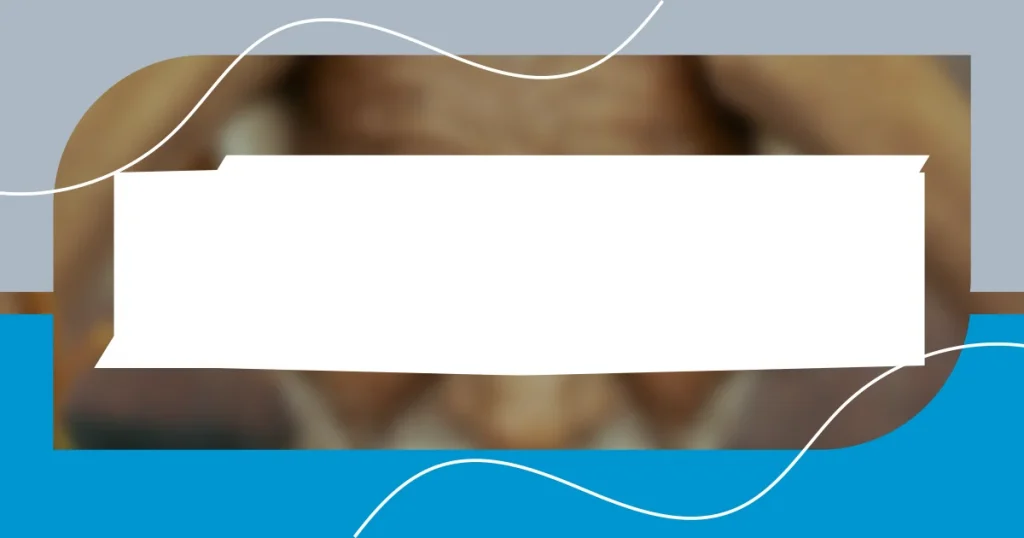Key takeaways:
- Unreliable narrators challenge readers to question their perception of truth, revealing complexities in human nature and memory.
- Common traits include selective truth, inconsistent behavior, and strong bias, prompting deeper engagement with character motivations and narrative construction.
- Reflecting on experiences with unreliable narrators fosters skepticism, self-awareness, and empathy, enriching the overall reading experience.

Understanding unreliable narrators
Unreliable narrators create a unique challenge for readers, as they can twist the narrative to fit their perspective, which often leads to intriguing and complex storytelling. I remember reading a novel where the narrator’s version of events shifted dramatically halfway through, leaving me questioning everything I thought I understood. Isn’t that what makes literature so captivating? The pivot forced me to reevaluate my assumptions, revealing just how easily we can be swayed by one individual’s viewpoint.
When I encounter an unreliable narrator, I often find myself grappling with my trust in their perspective. For instance, in one story, the narrator depicted themselves as a hero, yet their actions suggested a more self-serving motive. This inconsistency stirred a mix of frustration and fascination in me. How do you discern truth from fabrication in tales woven through such flawed lenses?
The beauty of unreliable narrators lies in their ability to reflect the complexities of human nature. They remind me of conversations I’ve had, where emotions can cloud judgment, leading to vastly different interpretations of the same event. Have you ever experienced a miscommunication where each party held a different version of the truth? This phenomenon emphasizes the unreliable nature of memory and perception, making the exploration of such characters not just entertaining but deeply relatable.

Recognizing common traits
Recognizing common traits of unreliable narrators requires keen observation and an understanding of their subtle nuances. One key trait I’ve noticed is their tendency to present selective truths. For instance, in a book I once read, the narrator would conveniently leave out details that painted them in a less flattering light. It’s fascinating how this omission can skew our perception of events, isn’t it?
Another common characteristic is their inconsistent behavior or emotional reactions. I recall a story where the narrator claimed to feel deeply for a character, yet their actions contradicted those claims. It left me puzzled and a bit frustrated, as I was forced to navigate my own feelings of confusion. Have you ever felt the same way when trying to untangle someone’s true intentions?
Lastly, unreliable narrators often exhibit a strong sense of bias. I remember encountering a narrator who was convinced of their moral superiority while making choices that deeply harmed others. This skewed perspective added layers to the narrative, prompting me to question, “Who gets to define right and wrong?” It’s these traits that keep readers engaged and compel us to look deeper into the character’s psyche.
| Trait | Description |
|---|---|
| Selective Truth | Omitting details to shape the narrative, leading to a skewed perspective. |
| Inconsistent Behavior | Contradicting emotions and actions, creating confusion and tension. |
| Strong Bias | A subjective viewpoint that challenges conventional morality, prompting deeper reflection. |

Analyzing character motivations
Understanding character motivations is crucial when engaging with unreliable narrators. I find that their motivations often stem from a need for control or validation, which is fascinating. For instance, I once read about a character who wove elaborate lies to maintain a façade of success. This not only unmasked their insecurity but also led me to ponder my own experiences with the pressure to appear flawless. Isn’t it intriguing how we sometimes craft narratives about ourselves, bending the truth to fit what we believe others want to see?
- Motivation for control: Characters may manipulate narratives to assert power over how they’re perceived.
- Desire for validation: A need for acceptance often drives characters to distort the truth, revealing their vulnerabilities.
- Escapism: Some characters create unreliable accounts to avoid facing painful realities, which mirrors our own coping mechanisms.
I remember a novel featuring a narrator who desperately sought to justify their past mistakes. They continuously painted themselves as a misunderstood victim while simultaneously denying their role in the chaos around them. The dissonance between their self-image and their actions struck a personal chord with me. I reflected on moments in my life where I, too, overshadowed accountability with excuses. It’s this shared struggle that makes analyzing these character motivations not just a literary exercise but a deeply reflective journey.

Impact on storytelling techniques
Engaging with unreliable narrators significantly alters the storytelling landscape. I remember reading a novel where the plot twisted so drastically due to the narrator’s frequent fabrications that it felt like a thrilling roller coaster ride. Each revelation forced me to reconsider everything I thought I understood, making my reading experience far more interactive and suspenseful. Have you ever felt that rush of excitement when a story took an unexpected turn because of a character’s deceit?
The use of unreliable narrators can also create a complex layer of tension between the reader and the story. In one instance, I connected deeply with a narrator who spun an elaborate tale of love, only to discover their version of events was heavily biased. This manipulation not only sparked frustration but forced me to engage critically with the text, prompting questions like, “What is this character hiding?” and “What is the truth?” It’s this active participation that can truly enhance our investment in a narrative.
Additionally, the presence of an unreliable narrator challenges conventional storytelling techniques by reshaping how we interpret reliability in narratives. I recall how an author masterfully played with this idea, inviting me to question the credibility of not just the narrator but also the supporting characters. It added depth to the story, leading me to ask, “Can anyone in this tale be trusted?” This layered approach transforms the reading experience into a puzzle, encouraging us to piece together the fragmented truth amid the chaos.

Techniques for engaging with narratives
One technique I use to engage with narratives featuring unreliable narrators is to actively question the information presented. For example, while reading a story with a narrator who both loved and resented their childhood home, I found myself tracking inconsistencies in their memories. This process brought a sense of discovery akin to solving a mystery. Have you ever felt the thrill of piecing together clues as you read? I certainly did, and it led to deeper insights about the character’s psyche.
Another powerful strategy is to identify emotional triggers within the narration. In my experience, an unreliable narrator often plays on my own feelings of empathy or frustration. I remember feeling both drawn to and repelled by a character who lied to protect their fragile self-image. That internal conflict made me reflect on how we, too, sometimes present versions of ourselves that we think others want to see. Just like that character, have you ever hidden behind a facade? This emotional connection creates a nuanced interaction with the story that feels authentic and personal.
Finally, I find that rereading scenes can shine new light on the narrative. After finishing a novel where the narrator’s revelations unfolded like a well-constructed puzzle, I went back to pivotal moments with a fresh perspective. It was as if I was opening a treasure chest of details I had previously missed. This rereading not only deepened my understanding but also made me appreciate the author’s craft. How rewarding it is to unravel the layers of meaning after realizing the first impression was merely a thread in the fabric of the story!

Personal reflections on experiences
I often find myself reflecting on how unreliable narrators add richness to my reading experiences. There was one novel I couldn’t put down, where the narrator’s misleading charm sucked me in, only for me to later realize how skillfully they twisted the truth to fit their narrative. It left me wondering, have I ever been deceived by someone’s charm in real life? That experience taught me that sometimes, the most captivating stories can emerge from the most deceptive voices.
I remember another time when I actually felt a sense of betrayal after the narrator’s big reveal. I had become so invested in their perspective, only to discover that their reality was heavily tainted by insecurity. This realization stirred a mix of emotions within me—anger, disappointment, and ultimately a deeper understanding of the human experience. It prompted me to ask myself, how often do we overlook the complexities in others’ stories, mistaking surface-level perceptions for truth?
Reflecting on the impact of unreliable narrators also brings to mind the moments of self-discovery they incite. During my journey with one specific character, I found their inconsistencies mirroring my own struggles with trust in relationships. It opened a dialogue in my mind about how we often wear masks to hide our vulnerabilities. Have you ever questioned your own authenticity because of the façades you perceive in others? These stories push us to not only question the narrators before us but also to examine our own lives through a lens of critical reflection.

Lessons learned from unreliable narrators
One of the key lessons I’ve learned from unreliable narrators is the importance of skepticism in storytelling. I distinctly remember reading a novel where the narrator painted themselves as a victim, only for their true nature to be revealed later. This experience made me curious—how often do we accept someone’s version of events without questioning it? It taught me that looking beyond the surface can unveil a richer truth.
I’ve also realized how these narrators can reflect our own insecurities. During my exploration of a character who wove elaborate lies to gain affection, I found myself reflecting on times I’d been less than honest to fit in. I often wondered—what drives us to misrepresent ourselves? This journey into their psyche nudged me to confront my own vulnerabilities, leading to a more authentic approach in my relationships.
Lastly, I discovered that unreliable narrators can foster deeper empathy. There was a novel where a narrator’s contradictions spoke volumes about their struggles with mental health. I felt a familiar pang in my chest—have I, too, been judged unfairly by others? This realization deepened my understanding of the complexities of human experience, reminding me that there’s often more to a story than what meets the eye. The nuance it added to my reading has stayed with me long after I closed the book.
















